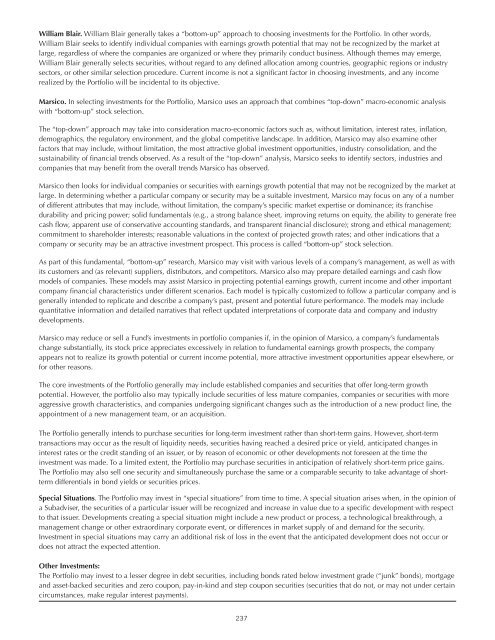Advanced Series Trust AST Academic Strategies Asset ... - Prudential
Advanced Series Trust AST Academic Strategies Asset ... - Prudential
Advanced Series Trust AST Academic Strategies Asset ... - Prudential
Create successful ePaper yourself
Turn your PDF publications into a flip-book with our unique Google optimized e-Paper software.
William Blair. William Blair generally takes a “bottom-up” approach to choosing investments for the Portfolio. In other words,<br />
William Blair seeks to identify individual companies with earnings growth potential that may not be recognized by the market at<br />
large, regardless of where the companies are organized or where they primarily conduct business. Although themes may emerge,<br />
William Blair generally selects securities, without regard to any defined allocation among countries, geographic regions or industry<br />
sectors, or other similar selection procedure. Current income is not a significant factor in choosing investments, and any income<br />
realized by the Portfolio will be incidental to its objective.<br />
Marsico. In selecting investments for the Portfolio, Marsico uses an approach that combines “top-down” macro-economic analysis<br />
with “bottom-up” stock selection.<br />
The “top-down” approach may take into consideration macro-economic factors such as, without limitation, interest rates, inflation,<br />
demographics, the regulatory environment, and the global competitive landscape. In addition, Marsico may also examine other<br />
factors that may include, without limitation, the most attractive global investment opportunities, industry consolidation, and the<br />
sustainability of financial trends observed. As a result of the “top-down” analysis, Marsico seeks to identify sectors, industries and<br />
companies that may benefit from the overall trends Marsico has observed.<br />
Marsico then looks for individual companies or securities with earnings growth potential that may not be recognized by the market at<br />
large. In determining whether a particular company or security may be a suitable investment, Marsico may focus on any of a number<br />
of different attributes that may include, without limitation, the company’s specific market expertise or dominance; its franchise<br />
durability and pricing power; solid fundamentals (e.g., a strong balance sheet, improving returns on equity, the ability to generate free<br />
cash flow, apparent use of conservative accounting standards, and transparent financial disclosure); strong and ethical management;<br />
commitment to shareholder interests; reasonable valuations in the context of projected growth rates; and other indications that a<br />
company or security may be an attractive investment prospect. This process is called “bottom-up” stock selection.<br />
As part of this fundamental, “bottom-up” research, Marsico may visit with various levels of a company’s management, as well as with<br />
its customers and (as relevant) suppliers, distributors, and competitors. Marsico also may prepare detailed earnings and cash flow<br />
models of companies. These models may assist Marsico in projecting potential earnings growth, current income and other important<br />
company financial characteristics under different scenarios. Each model is typically customized to follow a particular company and is<br />
generally intended to replicate and describe a company’s past, present and potential future performance. The models may include<br />
quantitative information and detailed narratives that reflect updated interpretations of corporate data and company and industry<br />
developments.<br />
Marsico may reduce or sell a Fund’s investments in portfolio companies if, in the opinion of Marsico, a company’s fundamentals<br />
change substantially, its stock price appreciates excessively in relation to fundamental earnings growth prospects, the company<br />
appears not to realize its growth potential or current income potential, more attractive investment opportunities appear elsewhere, or<br />
for other reasons.<br />
The core investments of the Portfolio generally may include established companies and securities that offer long-term growth<br />
potential. However, the portfolio also may typically include securities of less mature companies, companies or securities with more<br />
aggressive growth characteristics, and companies undergoing significant changes such as the introduction of a new product line, the<br />
appointment of a new management team, or an acquisition.<br />
The Portfolio generally intends to purchase securities for long-term investment rather than short-term gains. However, short-term<br />
transactions may occur as the result of liquidity needs, securities having reached a desired price or yield, anticipated changes in<br />
interest rates or the credit standing of an issuer, or by reason of economic or other developments not foreseen at the time the<br />
investment was made. To a limited extent, the Portfolio may purchase securities in anticipation of relatively short-term price gains.<br />
The Portfolio may also sell one security and simultaneously purchase the same or a comparable security to take advantage of shortterm<br />
differentials in bond yields or securities prices.<br />
Special Situations. The Portfolio may invest in “special situations” from time to time. A special situation arises when, in the opinion of<br />
a Subadviser, the securities of a particular issuer will be recognized and increase in value due to a specific development with respect<br />
to that issuer. Developments creating a special situation might include a new product or process, a technological breakthrough, a<br />
management change or other extraordinary corporate event, or differences in market supply of and demand for the security.<br />
Investment in special situations may carry an additional risk of loss in the event that the anticipated development does not occur or<br />
does not attract the expected attention.<br />
Other Investments:<br />
The Portfolio may invest to a lesser degree in debt securities, including bonds rated below investment grade (“junk” bonds), mortgage<br />
and asset-backed securities and zero coupon, pay-in-kind and step coupon securities (securities that do not, or may not under certain<br />
circumstances, make regular interest payments).<br />
237

















